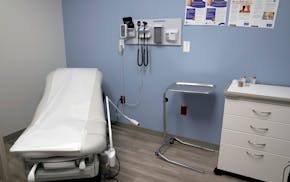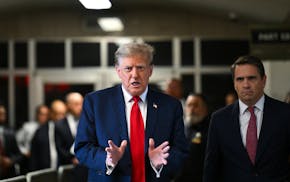U.S. boat sales were at record levels last year, but watercraft manufacturers hit a speed bump this month when new U.S. trade tariffs went into effect for aluminum and steel imports.
Europe, Canada and Mexico have retaliated with new taxes of their own on a host of U.S. made goods including metals, bourbon, soybeans and boats.
Some industry watchers are alarmed. About 40 percent of all U.S. boats are made of aluminum. And about 10 to 15 percent get exported to customers in other countries.
Thom Dammrich, president of the National Marine Manufacturers Association (NMMA), said many international boat orders were canceled as of last week, including 500 boats to Canadian dealers and millions in sales of yachts that would have gone to Europe.
"If this goes on for only 90 days, it is not that concerning. But if it persists, then it's very concerning," Dammrich said. "Right now, nobody knows" how long the trade war will last.
This month, association members reported that some aluminum sheet-metal prices jumped 25 and 30 percent, even when sourced from U.S. metal producers.
"We are starting to see some uptick in pricing regardless of where we are sourcing from," said Tracy Crocker, president of the BRP Marine Group, which bought the St. Peter, Minn.,-based fishing-boat maker Alumacraft Boat Co. in late June.
Some price hikes will get passed on to customers, but BRP hopes its large size and diverse pricing power will mitigate the volatility.
"Much of this [tariff issue] is out of our control," Crocker said. "But we think it's more [a] short-term rather than a long-term problem. At least we hope it's short."
In the midst of the uncertainty, two other recreational-vehicle makers are jumping into the boating business. Polaris just bought the largest maker of pontoons, Boat Holdings, while Winnebago bought Chris-Craft.
In a recent conference call with analysts, Polaris CEO Scott Wine said Polaris is "obviously experiencing" cost increases because of the tariffs.
"We have certainly factored that in," he said. "The assumption that we've got is that we'll be able to elevate the price of the boat. It's a very, very small increase relative to the overall cost in the boat. So we'll be able to pass that on."
Yet other boat manufacturers have told the association they have stopped hiring or are preparing for layoffs and also putting off investments because of the risks associated with the higher aluminum prices and overseas markets.
At the same time the NMMA has lobbied Capitol Hill and the White House for a quick resolution, executives said.
"The [Trump] administration is saying they have to do this," Dammrich said. "We have not heard anything from the administration that would lead us to believe that this would be short term. "
Several dealers in Minnesota have already reported higher prices on 2019 orders and wonder if more increases are on the way. State statistics show Minnesota has the most registered boats at 826,000 than any state but Florida.
If there is a silver lining, dealers say the tariffs might nudge U.S. boat makers to focus internally and address product backlogs to U.S. dealerships.
"There is not a U.S. [boat] manufacturer out there who is up to speed or keeping abreast with orders," said Jeff Hannay, co-owner of Hannay's Marine in Minneapolis, which currently only has two pontoons left in its showroom. New product orders have been delayed for weeks.
Gene Hallberg, the 82-year-old founder and CEO of Hallberg Marine in Wyoming, Minn., sells five lines of boats and pontoons, including the Boat Holdings brands purchased by Medina-based Polaris last week.
Hallberg, who employs 40, believes boat manufacturers may increase prices due to new aluminum tariffs, but only slightly.
"I have never had a year where the manufacturers didn't raise their prices," Hallberg said, who added he is more concerned about making up weak sales in April because of the weather.
Whatever the outcome, the tariff conundrum strikes on the heels of a blockbuster year for the entire industry.
According to the NMMA, new U.S. boat sales reached a record $13.5 billion in 2017, with help from Minnesota boat makers such as Premier Pontoons, Crestliner and Alumacraft.
With more than 90 percent of powerboats made in the U.S., exports of boats jumped 9.4 percent to $1.3 billion last year. Imports of boats, engines and other parts and materials for the industry hit a record $3 billion last year.
Recreational marine spending as a whole reached $39 billion last year in the United States, with $710 million spent in Minnesota. That's up 9 percent from 2015 and fourth among states. Floridians topped spending at $2.5 billion, followed by Texas and Michigan.
Whether spending will be affected by any price hikes or other effects of the tariffs is yet to be seen. However, Dammrich said the well-established boat-making industries in Minnesota and Wisconsin won't be immune.
"What will this mean to Minnesota? I think there are a lot of Lunds boats, Alumacrafts and Premier Pontoons there that probably export to Canada that will not be exporting as long as this tariff situation persists," Dammrich said. "If this persists, it will impact manufacturing employment in the boating industry and for any users of aluminum and steel."
China's economy grew 5.3% in first quarter, beating expectations
NASA confirms mystery object that crashed through roof of Florida home came from space station

New rules for Pregnant Workers Fairness Act include divisive accommodations for abortion
Saudi foreign minister arrives in Pakistan to discuss how to help with the country's economic crisis
